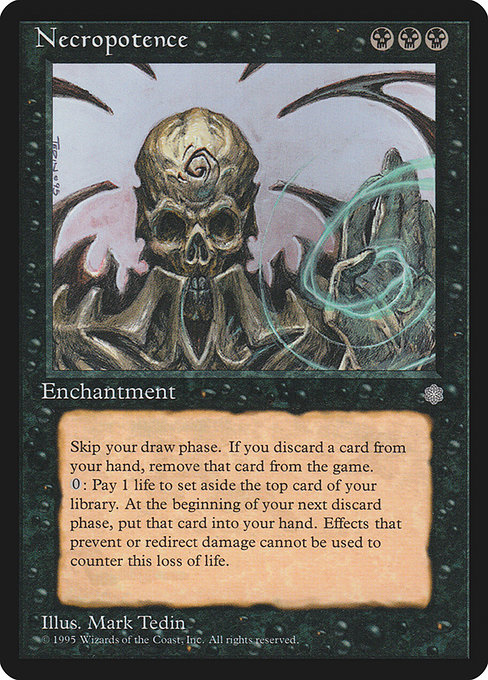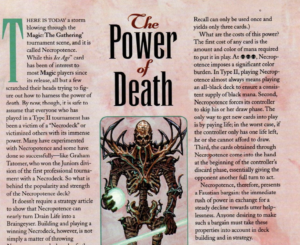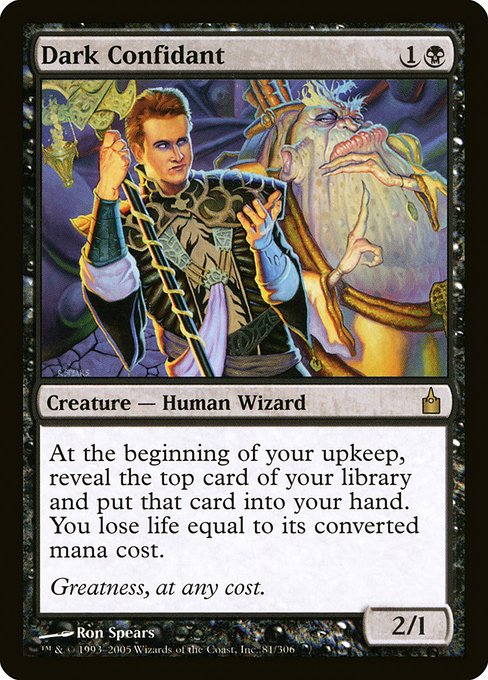Let’s make some enemies, shall we?
First off, a rhetorical point: the card Necropotence is pronounced NECK-ro-PO-tence. Why? The word is composed of two etymological cores: “necro” from the Greek nekros, meaning corpse, and “potence”—a Latin stem from “potent”—meaning “powerful.” Ahh, the excess of it all! However, I’ve heard players pronounce it the inverse way: nuh-CROP-uh-TENTS. We want to emphasize the “necro” and “potence”—not the “crop” and the “tents.” The latter (the *ahem* wrong way) is an iambic form—an unstressed syllable followed by a stressed one, the way most English words are pronounced. Turn the syllables around and you get a trochee—stressed unstressed.
But in Greek, especially older forms of Greek, the accents must fall on one of the last three syllables. Often the initial syllable is the one emphasized. Take the word rhetor, which is the root of rhetoric. In English, the instinct is to pronounce the word like reh-TER. But it’s pronounced RAY-tor. Other Greek words follow suit: logos, pathos, ethos, topos. Same with names like ArisTOTle and SOCrates. There’s also the long repeating “o” sound in the card’s name that lures us in. Necroooooo…

What Are You Willing To Pay?
Now that we have sounds out of the way. Let’s talk about what Necropotence does. It’s an Ice Age enchantment for {BBB}. Here’s the Oracle text:
Skip your draw step.
Whenever you discard a card, exile that card from your graveyard.
Pay 1 life: Exile the top card of your library face down. Put that card into your hand at the beginning of your next end step.
Phew. What this means is—well, you know what this means. Life points convert into cards. It’s a sick trade off. A powerful one, too. What are we talking about here, though? We’re talking the direct conversion of death into life. The closer a player gets to 0 points, the stronger, the more capable, the more options that player could possibly possess. The power of potential death. Who was it who said the only point that mattered in Magic was the last one?
Necropotence is an alluring card. It says: Break the rules, friend. Go on. You deserve it. Look at the skeletal mage on the card. He’s surrounded by bony armor with his hand in a summoning gesture. The mage is staring right at us. We, the players, are being enchanted. We’re being persuaded to get as close to losing as we can without losing.

A History of Bargains
I will admit a difficult fact here. I don’t actually own a copy of this card, which is depressing. The art is eerily wonderful. The ability is incredibly cool. My nostalgia for the mid-90s (my early teens) peaks when I think of the card in its heyday. Watching Bryan Davis go down in flames to Bob Maher in the 1999 Pro Tour Chicago Final on YouTube is a frigging joy. (Important point: It isn’t a joy because Davis lost. No, no, no. It’s because he so went fully in on Necroing himself into oblivion.) That match is a form of ASMR, really. Maher’s unique horizontal riffle shuffle. The snapping of the unsleeved cards as Davis counts them out. The Mark Tedin art shiny under the lights. The quizzical commentary from Brian David-Marshall. The scribbling down of life totals with a pad of paper and pen.
According to a “Running the Numbers” article from the September 1996 issue of The Duelist, 50% of semi-finalists, finalists, and champions at the Northwest and Great Lakes Championships all played Necrodecks. And as Robert Hahn wrote in another 1996 Duelist article, “The Power of Death”:
The most important principle to remember when playing a Necrodeck is what L.A.’s Mark Chalice calls the “parity situation.” A parity situation is achieved when neither side has an advantage in terms of cards in hand and cards in play, and you are at an equal but not dangerously low point in life. You and your opponent have traded card for card—you put out a Specter, he Plowshares it; you cast a Hymn and he counters it; you get out a creature, he gets out a creature; and so on. It is at this point that casting Necropotence can be so powerful.
The key takeaway here is this: Necropotence relies on risk. If one doesn’t risk, one can’t (or, rather, couldn’t) play a Necrodeck. The card itself takes on risk heavily. Black cards are about this: the risk. And yes, while the Dark Confidant flavor text is “Greatness, at any cost” (thank you, Bob Maher), I still feel that Necropotence isn’t stupid. It isn’t reckless. No. It’s addicted to risk. There’s a difference.
Why do we risk? What does it mean to risk in a game with so much strategy? Where does the improvisation lie in the variance of card draw? More importantly, can improvisation exist? Perhaps I crave Necrotpotence so much because I like the riskiness of it. The highwire act of dropping life total in favor of a potential edge.

Power from Beyond
When I was searching in Google Books for instances of the word “necropotence” prior to the Magic card, I thought I found one way back in a printing of a Bible from the 16th century. It was in the Book of John, Chapter 11. The Gothic script was hard to read so I had to use a contemporary translation to try and parse it, searching for words like “death” and “power,” but what had happened was an OCR (optical character recognition) issue. What a computer program deciphered as “necropotent” turns out is actually French for “ne croyotent”—which translates to “don’t believe.” Now, this is the variance of research. You think you find one thing, but you end up with something else. It’s a bust. Oh well. And yet part of me immediately thought that this was serendipitous and exactly what Necropotence encourages. The card goads. It whispers. Don’t believe don’t believe don’t believe…until its controller can’t take such goading anymore and taps the three black for an enchantment that will create the ultimate Faustian bargain.
This lopsided bargaining is shown in the need for the card’s ability, as it’s reflected in the cards influenced by it, e.g. Yawgmoth’s Bargain, Asmodeus the Archfiend, Griselbrand, Greed, and so on.

To me, Necropotence represents a card which asks: What do you value? Control? Speed? Card advantage? Life total? The graveyard? In a way, it doesn’t matter what our answer is, because Necro’s answer is: Choice. The card offers choice. And in a game where any given turn is usually locked into whatever you have in your hand, choice is a costly privilege.
When It’s Time To Cast Plans Aside
I’ve played a number of formats: Modern, Pioneer, Legacy, Pauper, Commander, and soon, Draft. I’m not an expert. Far, far from it. But in many of these formats, there’s a strict obedience to efficiency and pre-planning. I read and hear players talk about “lines of play”–that is, in much the way top chess players discuss classic openings, midgames, endgames. Even in the more casual formats, I hear this kind of talk. However, Necro seems to shrug off that attitude of pre-planning. To shake it up. Perhaps I’m totally wrong. Likely I am. I’m just a big fan of improvisatory play and chaos, and what appears like absolute chaos to me is Necropotence. So far as gameplay goes in Magic, it’s Dionysian in a Nietszchean sense—the full-grip embrace of revelry, chaos, collectivity, passion. (For more on this, please read fellow Hipsters Jacob Torbeck and Rob Bockman on Black cards and their cultural import.)
The MtG Wiki has in its entry for Black’s flavor in the color pie, the following description:
Black has a very cynical world-view, and its core philosophy is that of self-determination and release from society’s imposed limitations, so when things truly go awry, a Black hero capable of waking people up to reality is exactly what the world needs. This is because, beneath its wall of cynicism, Black is the color that most believes that it can change fate against the most impossible odds—even if it must stand alone.
Thank you, Nameless WikiScribe. I totally agree. Choice and risk are channeled against cynicism. Someone told me that the only important point in Magic is the last one. This is why I often don’t scoop. I make people kill me. Why? Because the right card could be on the top of the library, or your opponent could screw up. Never believe in fate. That’s what Necropotence, and cards like it, symbolize. Screw fate.
Necropotence was (and could be again?) a dark star of the game. Like many dark stars, it sucks in light and doesn’t let anything escape. And, unfortunately, it isn’t playable other than as a one-of in Commander and Vintage, where it’s restricted. It’s currently banned in Legacy, which tells you all you need to know. (Um, hello, Doomsday?) Which, sure. There’s a couple formats–a couple of lonely, solitary formats–where our skullish mage friend can call home. But is a singleton the right form of life for a risky bastard like Necropotence? I ask you, friends: is it?
Repeat after me…Embrace the Revel. Welcome the Dark. Consume your life.
Thus, to conclude: Hey, WotC: Print Necro into Modern, you cowards!
Kyle Winkler (he/him) is a teacher and fiction writer. While he was pre-teen when Magic: The Gathering was released, he didn’t start playing until recently. He’s the author of the cosmic horror novella (The Nothing That Is), a collection of short stories (OH PAIN), and a novel (Boris Says the Words). He’s trying to make Obzedat, Ghost Council work as the commander for his most recent deck.

